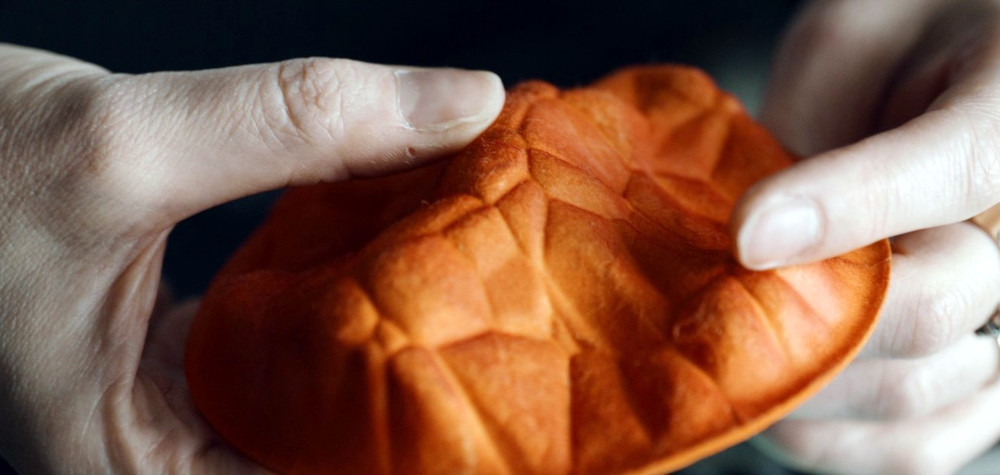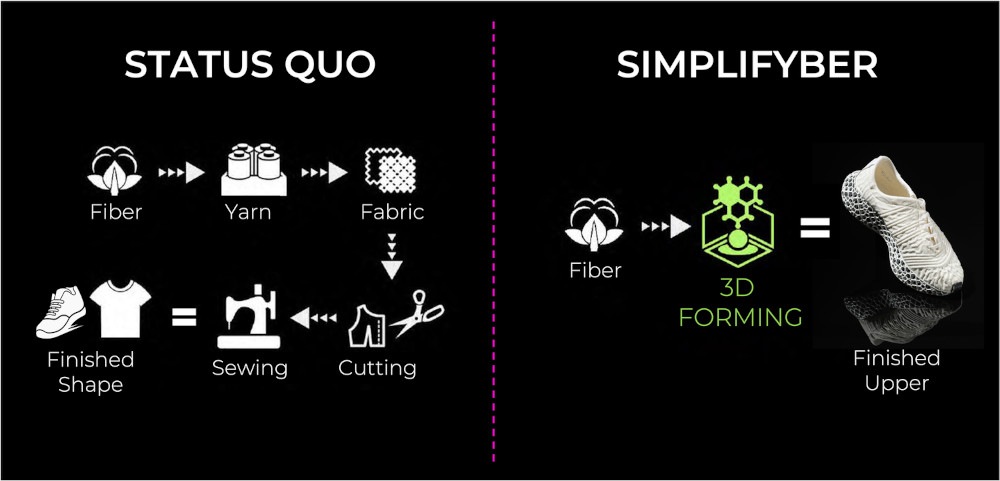The fashion world is renowned for creativity and innovation, with designers
fusing art with functionality. But behind its glamour lies the reality — it’s
one of the planet’s most polluting sectors. With 92 million
tons of textile
waste
generated annually and fashion accounting for 10 percent of global carbon
emissions,
traditional manufacturing processes are not just outdated — they’re destructive.
The prevalence of fossil fuel-based
fabrics,
combined with an intricate supply chain that stretches across continents, has
driven exploitation and chemical pollution throughout the industry.
More and more innovators are designing novel, plug-and-play solutions to help
rein in fashion’s many negative impacts — including biomimetic
technologies
that replace water- and chemical-intensive dyeing processes, creating circular
materials upcycled from everything from food
waste
to CO2
emissions,
and designing complex items such as shoes for easy disassembly and
recycling.
Adding to the list is Simplifyber, a North
Carolina-based startup that offers a whole new approach to textile
manufacturing. The company has created a cellulose-based liquid from renewable
plant sources that can be molded into a versatile textile, using its novel
technology. The company’s tech platform replaces 60 percent of the traditional,
resource-intensive processes related to garment production with a more
streamlined system that significantly reduces resource use and environmental
impact. The approach cuts down both waste and energy consumption, and offers a
scalable solution for sustainable fashion manufacturing.
"After 24 years in luxury fashion, working on runway collections in Europe
and the US, I saw firsthand how backward the manufacturing system is: an
inefficient bottleneck of spinning, weaving, cutting and sewing; coupled with
outsourcing to developing countries where there is a lack of oversight and
regulations — and consequently, pollution,” Simplifyber co-founder and CEO
Maria
Intscher-Owrang, who
previously worked as a designer at fashion houses including Alexander
McQueen and Vera Wang, tells Sustainable Brands® (SB). “I thought,
‘There has to be a better way.’”
From the kitchen to the lab
 Image credit: Simplifyber
Image credit: Simplifyber
Simplifyber’s journey began with kitchen experiments by Intscher-Owrang and her
co-founder, Philip Cohen,
who were trying to find a more sustainable way to create fabrics.
“Maria and I were introduced by a mutual friend and classmate of mine from
business school,” Cohen tells SB. “After a couple of phone
calls, I asked Maria to come out to Nashville — where I was living at the
time — and show me what she had in mind. She asked if she could get a couple of
my kitchen pots and pans dirty; and within a few minutes, she was smearing this
fiber paste she had made in my kitchen onto a plastic mannequin that she had
brought with her. After the paste dried, we peeled it off the mannequin and it
was a vest.
“I could see the vision and a clear path forward; and the proposition to disrupt
and improve a massive industry like fashion was exciting to me. And maybe the
most exciting thing was that this idea could be applied to various markets
outside of fashion, as well.”
The two tested different fibers, looking for a method to mold them directly into
shape without the traditional weaving and sewing steps.
“We were just trying to see what fibers would be like when worked directly into
a form," Intscher-Owrang recalls.
However, they quickly realized that the complexity of their idea required
professional tools and expertise beyond what they could do at home. So, in 2021,
they assembled a team of chemists and partnered with research groups to refine
their early concept of molding fibers directly into garments. This transition
marked a turning point for the company — moving it from small-scale experiments
to a sophisticated lab environment. The result: pouring liquid cellulose,
derived from renewable plant sources, into molds — eliminating the need for
spinning, weaving, cutting and sewing.
“Much like traditional manufacturing, we start with fiber — but then, skip all
the other steps and jump straight to the end by pouring our liquid slurry of
fibers into a three-dimensional mold. These fibers are chemically bonded
together to create our products,” Intscher-Owrang explains. “So, at scale, this
is vastly more efficient and automated and will enable a relatively small
facility to make in a single day what a traditional sewing factory makes in a
month with 100 sewers.”
Simplifyber hasn’t just introduced new materials — it has reimagined the entire
textile manufacturing process. By eliminating 60 percent of traditional
manufacturing steps, the process dramatically reduces waste, energy use and the
greenhouse gas emissions generated by conventional methods.
The company is currently focusing on applications in the automotive and
especially footwear industries. Its technology can produce shoe uppers in a
matter of hours — a fraction of the time needed for conventional methods.
Simplifyber textiles are made from biodegradable, bio-based materials sourced
from a variety of plant-based and recycled sources — including cellulose derived
from FSC-certified wood pulp, recycled cardboard, hemp and even recycled
clothing — ensuring a lower resource demand compared to traditional fabrics.
Another advantage of Simplifyber’s process is the potential for on-site
production. With this technology, apparel companies and manufacturers can
produce garments at their own facilities — reducing the need for international
transportation.
Enhancing garment worker value
 Image credit: Simplifyber
Image credit: Simplifyber
As industries adapt with automation, concerns about job displacement arise —
especially in fashion, where many garment workers are sourced from
developing countries. However, Intscher-Owrang believes that Simplifyber’s
approach can enhance the value of skilled garment workers rather than displace
them. She explained that Simplifyber is not trying to replace people, but
instead trying to eliminate the most repetitive and labor-intensive parts of the
process so that workers can focus on what really matters: their craftsmanship.
“Traditional manufacturing is not going to go away, because there are a lot of
products that you can’t make this way [molding]; but it can replace a layer of
what can be replaced and raise the perception and value of things that can’t,”
she says.
Through automation, Intscher-Owrang believes that those whose skills are truly
irreplaceable can be fairly compensated, positioning them as vital players in a
more efficient and equitable fashion industry.
And as most clothing and shoe brands hire out their manufacturing, Simplifyber
would just be a different supplier. This adaptability allows its technology to
integrate seamlessly into existing supply chains, encouraging brands to rethink
their production processes.
Future collaborations and commercialization
As Simplifyber prepares to launch its first product — a shoe upper — next year,
the reaction from the fashion world has been overwhelmingly positive; excitement
is building among brands eager to integrate this technology into their
operations.
“For now, we’re focused on manufacturing ourselves because we can’t just
introduce a new piece of equipment and expect people to know how to use it,” she
explains. “We need to demonstrate what’s possible with real products, create
tangible examples, and collaborate closely with factories and brands. This way,
we can help manufacturers feel comfortable with the new technology.”
Intscher-Owrang’s extensive network in the fashion industry has been
instrumental in helping Simplifyber collaborate with prominent brands: The
company recently unveiled the first look at its first collaboration — the
GANNI x Simplifyber "Moon
Shoe,"
produced with Scandinavian ready-to-wear brand
GANNI — set to debut at Paris Fashion Week
Spring 2025. Another collab with a car manufacturer that will be announced
soon.
In the coming years, Simplifyber aims to further enhance its impact by scaling
production and expanding its offerings beyond footwear and automotive parts.
“In five to ten years, our goal is to diffuse this technology by selling both
the equipment and the material slurry. This approach will enable us to reach
more of the industry than we could as just a manufacturer,” Intscher-Owrang
explains. “It’s crucial for us to transform as much of the industry as possible
and open up opportunities for others to adopt this innovative manufacturing
process.”
Get the latest insights, trends, and innovations to help position yourself at the forefront of sustainable business leadership—delivered straight to your inbox.
Scarlett Buckley is a London-based freelance sustainability writer with an MSc in Creative Arts & Mental Health.
Published Dec 4, 2024 8am EST / 5am PST / 1pm GMT / 2pm CET